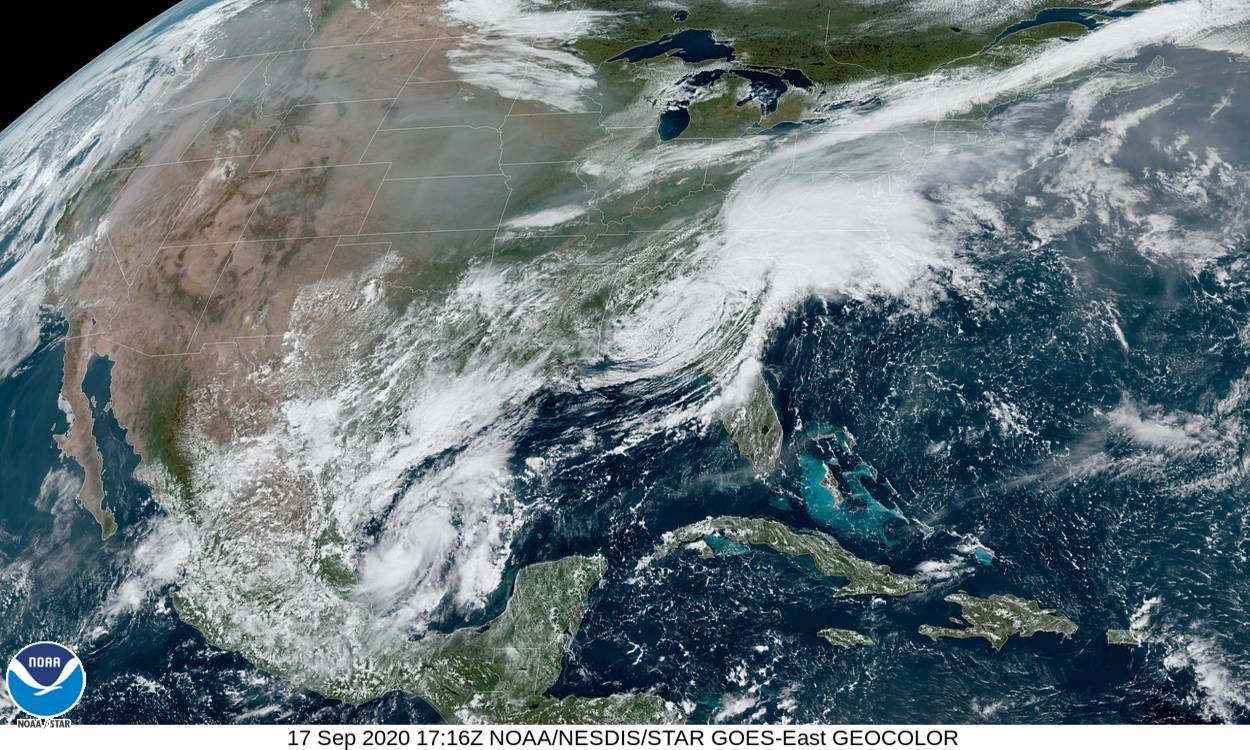
Image from the NOAA GOES-East CONUS in GeoColor, 17 September, 2020. Note the broad “smoke gray” band stretching across the continental US from the West Coast (California) to well beyond the US Northeast and out over the North Atlantic, well east of Nova Scotia.
In a scene reminiscent of the view from Tatooine or from a planet orbiting a red dwarf star, this author witnessed a remarkable sunset this week.
By now, everyone should be aware of the unprecedented fires engulfing the US State of California. As the climate continues to change and warm unabated, the frequency and intensity of fires such as this will continue to increase as will the other aspects of a warming climate.
Here in the US Northeast, the air as of late has been tainted with the distinct taste and scent of burning wood, an odor uncharacteristic for mid-September, still in the mid 70s but reserved more for the colder winter months; what is expected and would be consistent with this tinge in the air is the red, attenuated light of the setting sun, red and attenuated by the haze and/or humidity characteristic of region, not from smoke and soot from fires raging 4,000 km to the west!
These seasonal fires are largely fueled by the regionally arid conditions combined with seasonally strong winds. Over the millennia, the environment and regional biome have evolved and adapted to include these fires as part of the seasonal changes of the region. What the environment and biome haven’t adapted to is the rapid temperature increase driven largely by anthropogenic (man made) climate change.
According to a recent study, warm-season days in California have increased by over 2.5 degree since the early 1970s.
According to the study
“The clearest link between California wildfire and anthropogenic climate change thus far has been via warming-driven increases in atmospheric aridity, which works to dry fuels and promote summer forest fire”
Much in the same way that the air in a warm house rushes out an open door on a cold winter’s night, creating a temporary “drafty” condition at the door, wind is the atmospheric transfer of energy, the “open door” on a regional or planetary scale and is nature’s attempt to achieve equilibrium locally or regionally (ex. from the tropics to the poles). As the temperature gradient (the difference between hot and cold) increases, so does the wind speed or the speed at which nature attempts to reestablish equilibrium.
Why do I mention wind within this context since we’ve already established the seasonal expectation for the fires whose contributing factors include the regionally arid conditions, the normally warm temperatures and given wind conditions.
Contributing Factors
As the temperature increases:
the temperature gradient and wind speed increases, further fanning the flames of an already dry and volatile condition;
the landscape becomes more arid and parched, a literal “tinderbox” waiting for a lightning strike or just the right conditions to burst into flames.
In short, higher temperatures mean a drier and more arid landscape and parched environment; it’s that simple.
Additional resources
NOAA GOES, the National Oceanic and Atmospheric Administration Geostationary Satellite Server
URL to Title Image:
https://www.star.nesdis.noaa.gov/goes/conus_band.php?sat=G16&band=GEOCOLOR&length=180
Imagination is more important than knowledge
![]()
An index of all articles can be found here.
If you enjoyed this article, please consider supporting us with a modest donation
or through a subscription on our Patreon Page
Membership at Astronomy for Change is Free!



